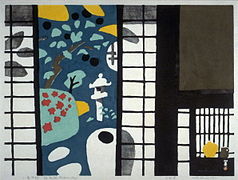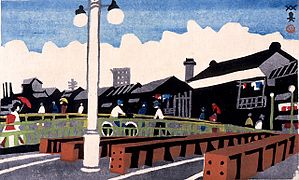Kawanishi Hide
Kawanishi Hide ( Japanese 川西 英 ; born July 9, 1894 in Kobe ( Hyōgo prefecture ); died February 20, 1965 ; real first name Hideo ( 英雄 )) was a Japanese woodblock artist and painter.
life and work
Kawanishi lived in Kobe all his life. At the age of 14 he attended middle school, at 15 he switched to the trade school in Hyogo Prefecture in Kobe. During his school days, stimulated by the magazine Shirakaba , he occupied himself with Western painting. In addition to Takehisa Yumeji, he was influenced by van Gogh , Cézanne and Gauguin . With his classmates he founded the literary group “Young Bamboo” ( 若 竹 会 , Wakatake-kai ) and began making woodcuts as a student . In 1914, a trip organized by the school took him to China, where a number of cities were visited.
After graduating from commercial school in 1915, Kawanishi showed an interest in his family's shipping business but, to the regret of his father, decided to take on a family-owned post office. In this way, with a certain financial independence, he could continue to devote himself to woodcuts, which became his main occupation from 1920 onwards. In 1922 he showed at an exhibition of the "Japanese Society of Creative Woodcut" ( 日本 創作 版画 協会 , Nihon sōsaku hanga kyōkai ), of which he became a member in 1932, in Kobe for the first time some prints. In late 1920 he was appointed head of the Higashide Post Office in. In 1931 Kawanishi exhibited at the National Painting Society ( 国画 会 , Kokuga-kai ), which he then joined in 1935.
Kawanishi created articles for various art magazines, participated in the series "100 New Views of Japan" ( 新 日本 百 景 , Shin Nihon hyakkei ), in the first three series, the Onchi Kōshirō's "First Monday [of the month] meeting" ( 一 目 会 , Ichimoku-kai ) and on the folder “Japanese Folk Customs” ( 日本 民族 図 譜 , Nihon minzoku zuu ) and “Customs of the Japanese women ” ( 日本 女 俗 選 , Nihon jozoku-sen ), which appeared in 1946. In the 1940s, the educator and art collector Ikenaga Hajime (1891–1955) became aware of Kawanishi, bought prints and supported him.
Kawanishi's work is characterized by the use of primary colors, with white and black also being used as colors. He refrained from creating contours with black lines. Since the colored areas have no shading, many of the pictures appear to have been cut out of colored paper.
Works (selection)
- "12 Month Views of Kobe" ( 神 戸 十二 か 月 風景 , Kobe jūni-ka-getsu fūkei ; from 1931)
- "100 Views of Kobe" ( 神 戸 百 景 , Kobe hyakkei ; 1933 to 1936)
- "100 New Views of Kobe" ( 新 ・ 神 戸 百 景 , Shin Kobe hyakkei ; 1952 to 1953)
photos
Others
Kawanishi's third son, Yusaburō (* 1923) also became a painter and continued his father's style.
Remarks
- ^ A b Glass window in the Sannomiya Center shopping street in Kobe. Two prints from the "100 Views of Kobe" served as templates for the glass windows.
literature
- Kobe shiritsu hakubutsukan (Ed.): Kawanishi Shin-Kyu-Kobe Hyakkei. Catalog, 2001.
| personal data | |
|---|---|
| SURNAME | Kawanishi, Hide |
| ALTERNATIVE NAMES | 川西 英 (Japanese, stage name); 川西 英雄 (Japanese, real name); Kawanishi Hideo (real name) |
| BRIEF DESCRIPTION | Japanese painter and woodcut artist |
| DATE OF BIRTH | July 9, 1894 |
| PLACE OF BIRTH | Kobe |
| DATE OF DEATH | February 20, 1965 |
| Place of death | Kobe |






